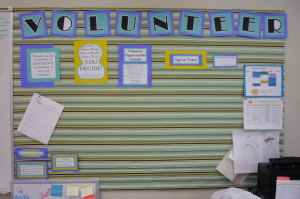A new book on volunteer activity is in the making for the ISTR Book Series: Perspectives on Volunteering: Voices from the South. The aim of this volume is to articulate and examine theories, and perspectives on volunteering in the “South”, meaning presenting various angles of volunteer activity in countries considered developing countries and countries in transition. Comparative issues of all countries are welcome as well as examples of volunteering in North/South or South/South experiences.
There is a group authors already involved in this publication. “We are interested in would be authors that are working on these issues. To researchers with an interest in this topic, this is an open invitation to attend a meeting at the ISTR conference in Muenster [Germany]. For those who cannot attend and are interested, please contact the editor.”
Place: University of Muenster (Germany). Room Vom Stein Haus VS-17
Time : Friday, July 25. 12:30 PM.
parallel to the International Society for Third Sector Research (ISTR) International Conference
Editor: Jacqueline Butcher, Ph. D
RSVP: jacqueline.butcher@ciesc.org.mx
More info:
The chapters in this book approach volunteering through a series of essays and case studies that present recent academic research, thinking and practice on volunteering. Working from the premise that volunteering is “universal” this collection draws on experiences from Latin America, Africa including Egypt and selected parts of Asia. There is a focus on developing countries and countries in transition documents a fresh set of experiences and perspectives on volunteering. These accounts complement the conventional focus in the literature on ‘the developed’ world – largely northern or western experiences from Europe and North America. While developing countries and countries in transition are in the spotlight for this volume, the developed country experience is not ignored. Rather it is used in this anthology, as a critical reference point for comparisons, allowing points of convergence, disconnect and intersection to emerge.
The primary aim and contribution of this anthology will be to articulate and examine the opinions and perspectives on volunteering in the South. The second objective is to provide a counter point to the dominant conceptual and empirical account of volunteering. Consequently, in identifying chapters the proposed editor did not discount evidence from northern and western countries and rather included this where possible in survey and quantitative studies as a useful reference point and basis for comparison. Finally, the tertiary objective promotes the fuller complexity and texture on volunteering, highlighting its promotion through an appreciation of its potential and promise for expression and impact in different cultures and contexts.
Authors and suggested chapters to date:
Section 1: Volunteering: An introduction and theoretical framework
Chapter 1: Volunteering: a complex social phenomenon
Jacqueline BUTCHER
Section 2: Patterns of Volunteering
Chapter 2: The economic value of volunteering: Comparative estimates among developing, transitional, and developed countries.
Lester SALAMON and Megan HADDOCK
Chapter 3: The effects of volunteering on poverty and development in China, Ghana, Kenya, Mozambique, Nepal and the Philippines
Volunteer Services Overseas (VSO) and the Institute of Development Studies, Sussex University.
Chapter 4: Youth, service and volunteering: A comparative perspective in developing nations.
National Youth Service (NYS)
Chapter 5: The global perspective in corporate volunteering: a focus on the South.
Ken ALLEN
Section 3: Empirical approaches
Chapter 6: Organic/ indigenous practices of volunteering in Uruguay: The influence on Public Policy.
Analía BETTONI and Javier PEREIRA
Chapter 7: Solidarity and Volunteering: a Mexican Study.
Jacqueline BUTCHER and Gustavo VERDUZCO
Chapter 8: Individual volunteering and giving: How and why ordinary individuals give in the context of South Africa: a case study of Gauteng Province.
Susan WILKINSON-MAPOSA
Chapter 9: Promising practices from national programs across the African continent: Preparing youth for citizenship , employment and sustainable livelihoods.
Helene PEROLD and Karena CRONIN
Chapter 10: A typology of local and International volunteering experiences from Tanzania and Mozambique.
Helene PEROLD
Chapter 11: Volunteering at the grassroots: Celebrating the Joy of Volunteering in India
N. DADRAWALA
Chapter 12: Beyond images and perceptions: How important is voluntary action in Buenos Aires?
Mario ROITTER
Chapter 13: Employee volunteering in South Africa.
Fiona BUDD
Chapter 14: Models, developments and effects of trans-border youth volunteer exchange programmes in eastern and southern Africa.
Jacob MATHI
Chapter 15 : Volunteerism and the state: understanding the development of volunteering in China
Ying XU and Ngai PUN
Chapter 16: NGO management of volunteers: the case of Egypt.
Hisham EL ROUBY
Section 4 Conclusions -Volunteer participation.
Chapter 17: Conclusions about experiences and perspectives that come from the South.
Jacqueline BUTCHER
More information about the editor:
Dra. Jacqueline Butcher García-Colín
Directora, Centro de Investigación y Estudios sobre Sociedad Civil, A.C.
conocimiento para la acción social
Tecnológico de Monterrey, Campus Ciudad de México
Escuela de Humanidades y Ciencias Sociales





